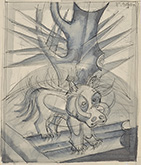FONDO 1892 - ROVERETO 1960
Depero was born in 1892 in Fondo, a small village in the Val di Non valley. He moved with his family to Rovereto, which at that time still belonged to the Austro-Hungarian Monarchy. Depero grew up in Rovereto and it was here he first began exhibiting his works. Having always been passionate about art in all its forms and fields, he made a trip to Rome in 1914, which was later to represent the most important turning point in his life, both on an artistic and personal level. In the Italian capital, he made the acquaintance of two well-known representatives of the Futurist movement: Giacomo Balla and Filippo Tommaso Marinetti. It was with Balla in 1915 that he wrote the Manifesto di Ricostruzione Futurista dell'Universo, in which they describe themselves as Futurist abstractionists. From then on, Depero's life was marked by encounters, journeys and important projects that contributed to radically changing the world of art, advertising and design.
In 1919 he founded the Casa d'Arte Futurista in the historic centre of Rovereto, which specialised in producing toys, tapestries and furniture in the futurist style. In 1925 he represented the futurists at the Exposition Internationale des Arts Décoratifs et Industriels Modernes, and presented a Futurist Hall at the Monza Biennial. In 1927, Fortunato Depero designed Depero futurista 1913–1927 which was printed in letterpress with his direct supervision. It was a commercial book to be sold, to promote and document the work of Depero, and to legitimise him as an artist, but it was also an atypical and pioneering artwork in the form of a book.
1928 saw Depero move to New York City. From this year to 1930, his works were not successful. The city was still reeling from the effects of the Wall Street crash so his paintings did not sell. He experienced a degree of success later on, doing costumes for stage productions and designing covers for magazines. He also dabbled in interior design during his stay. In 1930 he returned to Italy. In the 1930s and 40s Depero continued working, although due to futurism being linked with fascism, the movement started to wane. After the end of the Second World War, Depero had trouble with authorities in Europe and in 1947 decided to try New York again. This time he found the reception not quite as welcoming. From the winter of 1947 to late October 1949 Depero lived in a cottage in New Milford, Connecticut, relaxing and continuing with his long-standing plans to open a museum. After New Milford, Depero returned to Rovereto, where he would live out his days. In August 1959 Galleria Museo Depero opened, fulfilling one of his long-term ambitions.
